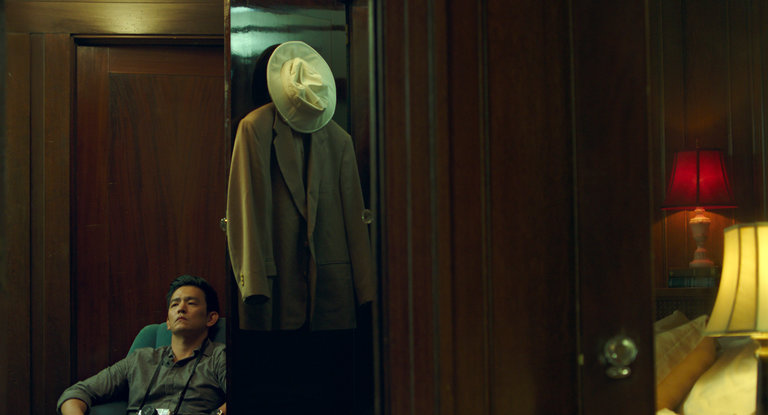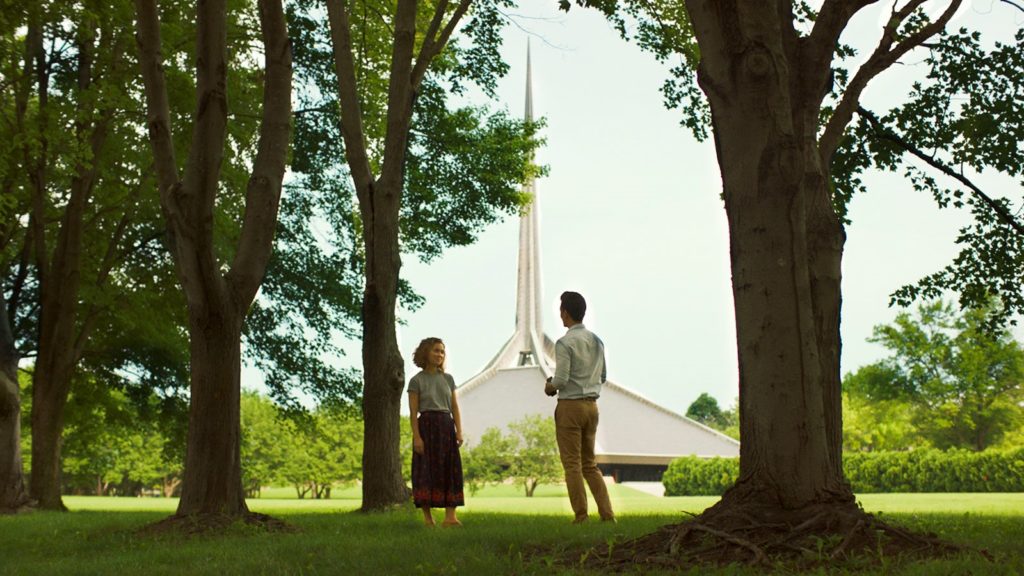
Columbus is the first feature film from the mononymous Kogonada, a video essayist known for crafting dissections of everything from Ozu to Breaking Bad. With Columbus, Kogonada takes a step forward, putting his knowledge of theory into practical use and crafting a gentle portrait of people in turbulence.
The film follows two characters in generally equal amounts. One, Jin (John Cho), is an English-to-Korean translator based in Seoul arriving in Columbus, Indiana, after his distant father, a local architecture professor, is suddenly sent into a coma and hospitalized. The other, Casey (Haley Lu Richardson), is a recent high school graduate, architecture buff, and Columbus native, hesitant to leave for fear of how her mother will survive without her.
Jin spends most of his days in Columbus walking idly, occasionally smoking or drinking. He feels anger at his father for never being loving or caring to him, anger at being forced to leave his work and life to see a dying man he feels no affection towards. Jin would rather be anywhere in the world rather than Columbus, Indiana.
Casey spends her days working at the local library with recent master’s graduate Gabriel (Rory Culkin). At night, she cooks for her mother, a working class woman and recovering meth addict. In her free time, she studies the city’s local architecture. (Columbus is evidently some sort of holy land of modern American architecture). She couldn’t imagine being anywhere other than Columbus.

The two characters meet by chance and strike up a conversation. They have an intellectual commonality and quickly become friends. Their proceeding conversations cover an array of topics: the value of architecture as an art, what one owes their parents, etc, etc. It’s clear that the two have an intrinsic connection, but what they are supposed to make of that is unclear to them.
Both characters are isolated and alone, but the age gap is jarring and the prospects of the union unclear. Mostly the two want to help each other see the way forward that they themselves cannot find. Jin must come to terms with his dying father (not reconcile, merely accept), and Casey must see that there is a future for herself outside of being a de-facto caretaker.
In its way, the story is quietly moving, though occasionally I felt as though I wasn’t picking up on the broader ideas of the story. The precision editing and expert framing sort of lulled me into a trance where I felt like I was just moving alongside this gentle story.
But that is Kogonada’s great trick on the audience — this is not a gentle story. Though it might feel like Linklater’s Before Sunset, the story is very turbulent. Jin has no emotions towards his father, actively wishing for him to die. Casey is in a toxic co-dependent relationship with her formerly addicted mother. The two become entwined in a potentially romantic relationship that is left purposefully vague as to whether it ever became sexual, the power-dynamics of which would be off.
Yet you can’t help but feel at peace watching the movie unfold. Its pace is so soothing, the framing so consistently beautiful — the experience so pleasant. Kogonada has such an incredible eye for the areas surrounding people, from the natural to the artificial, I found myself looking at every building on my walk back home with a new eye.

An argument arises in the movie whether architecture has healing properties. Jin, a cynic to the art (“When you grow up around something you become numb to it”), finds the idea to be bullshit, but Casey, who becomes enthralled with the local buildings during a turbulent time in her life, finds meaning in the idea. Maybe the buildings didn’t actively heal her, but they were there for her to find — and she found meaning in them.
Early on, Gabriel presents an argument he had just read to Casey on the idea of interest versus patience, and how, with disparate art forms, there is no unifying way to judge the value of one over another (in his example, books vs. video games). It just depends on the interest of the consumer. Do we lose something by losing interest in words on page, he posits? Theoretically, no. But what if we lost interest in every day life?
The conversation raises plenty of questions I’m sure Kogonada wanted the viewer to carry throughout the feature. Mostly I thought of the argument as Jin and Casey wondered if art could heal. I applied the argument to film. Can film heal? To me, the answer is obvious. But I’m sure there are so many people who simply don’t have interest in the form, and therefore would never have the patience to let the art heal them.
I can imagine Columbus being a healing movie for some.
Columbus
2017
dir. Kogonada
104 mins
Now playing until September 14th at The Brattle!

